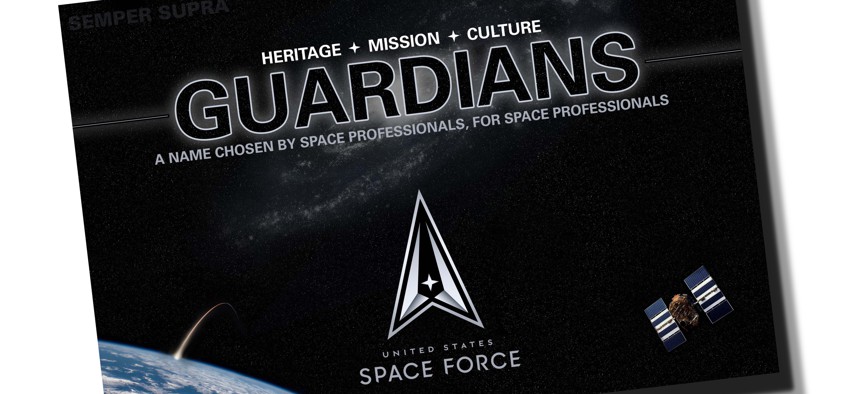Space Force Troops Get a Name: ‘Guardians’
VP Pence revealed the moniker for Trump’s oft-teased newest military service branch to stand alongside soldiers, airmen, sailors, and Marines.
Two days before the U.S. Space Force’s first birthday, its troops received their collective name: Guardians.
The new name for military’s space professionals, announced on Friday by Vice President Mike Pence, may appear to be a play on the Marvel superhero film “Guardians of the Galaxy.” But Space Force officials said it was a callback to a 1983 motto.
Since its standup on Dec. 20, 2019, the Space Force has grown to about 2,400 active-duty personnel, mostly Air Force personnel who were responsible for the military’s space mission before the new service was created. In 2021, the Space Force is expected to grow to about 6,400 active-duty Guardians, as Army and Navy personnel start transfering into the new service, Gen. Jay Raymond, the chief of space operations, said on a call with reporters earlier this week.
Raymond on Sunday will officially become a member of the Joint Chiefs.
The Space Force’s first year has been a “full-on sprint,” said Justin Johnson, a top defense official who is performing the duties of the assistant defense secretary for space policy.
In addition to the Space Force, there’s a handful of new space organizations around the Defense Department. There’s the U.S. Space Command, a combatant command that provides space support to military commanders around the world. There’s the Space Development Agency, a satellite buying organization that pre-dates the new service. It has ambitious goals to buy one satellite per week. And there’s Johnson’s job, a new top-level Pentagon position established by the same law that created the Space Force.
“A lot of them are still growing and maturing, but now it's just about delivering results,” he said. “And there's ton of work to do.”
Johnson played a key role in the reorganization of the Pentagon’s space enterprise. He was a top aide to former Deputy Defense Secretary (and acting Defense Secretary) Patrick Shanahan, who was put in charge of looking at ways to reorganize the management structure of the military’s space activities.
Despite bipartisan support in Congress for creating a space-focused branch of the military there was plenty of resistance, largely within the Pentagon. Most officials believed the military’s space mission was important, particularly as since China and Russia were building spacecraft and weapons that could disrupt American satellites, but how to organize these space professionals was hotly debated.
“The hardest part in standing up the Space Force, honestly, was internal Pentagon bureaucracy and...traditional resistance to change,” Johnson said. “But we fought through that. We got support in Congress [and] we got support from the president obviously.”
President Trump first called for a Space Force in 2018. One year earlier, top Pentagon officials fought Congress over plans to create a Space Corps within the Air Force. Ultimately that’s what ended up happening as the Space Force today is part of the Department of the Air Force, just as the Marine Corps is part of the Department of the Navy.
If Congress had approved Pentagon leaders’ 2019 plan to stand up the Space Force, the sixth branch of the U.S. military would have been created this year. But lawmakers wanted to move faster.
Form the onset, the service has been an occasional target of late-night comedians. Netflix even launched a satire starring Steve Carell — and the streaming network renewed the show for a second season in January. But those involved say the service is no laughing matter.
“It wasn't like Congress, or this administration, just woke up one day and wanted to do this,” Johnson said. “It was real threats against U.S. capabilities.”
While it’s members don’t yet have their own uniforms — they still wear their Air Force blues, with a U.S. Space Force name tape on their camo — they have a mission, one of increasing importance as U.S. officials charge China and Russia are regularly making moves to hold American satellites and space at risk.
“I think our biggest area that we need to spend a lot of mental energy on in the next year is really thinking about the long term competition with China and Russia,” Johnson said. “We want space, a space domain that's safe, secure, sustainable, stable.”
Just this week, U.S. officials said Russia launched a new missile that could destroy satellites in low-Earth orbit. It’s Russia’s third test of an anti-satellite weapon this year, according to Space.com.
“Russia’s persistent testing of these systems demonstrates threats to U.S. and allied space systems are rapidly advancing,” U.S. Army Gen. James Dickinson, the head of U.S. Space Command, said in a statement Wednesday.
Looking ahead, Johnson said it’s “less about institutional changes as more about delivering product. I think a lot of the work that they have in front of them is really fleshing out their vision for what the Space Force needs to look like over the next 20 or 30 years, force design, and force development of this new organization.”
NEXT STORY: Trump Officials Reviewing DOD Support To CIA





